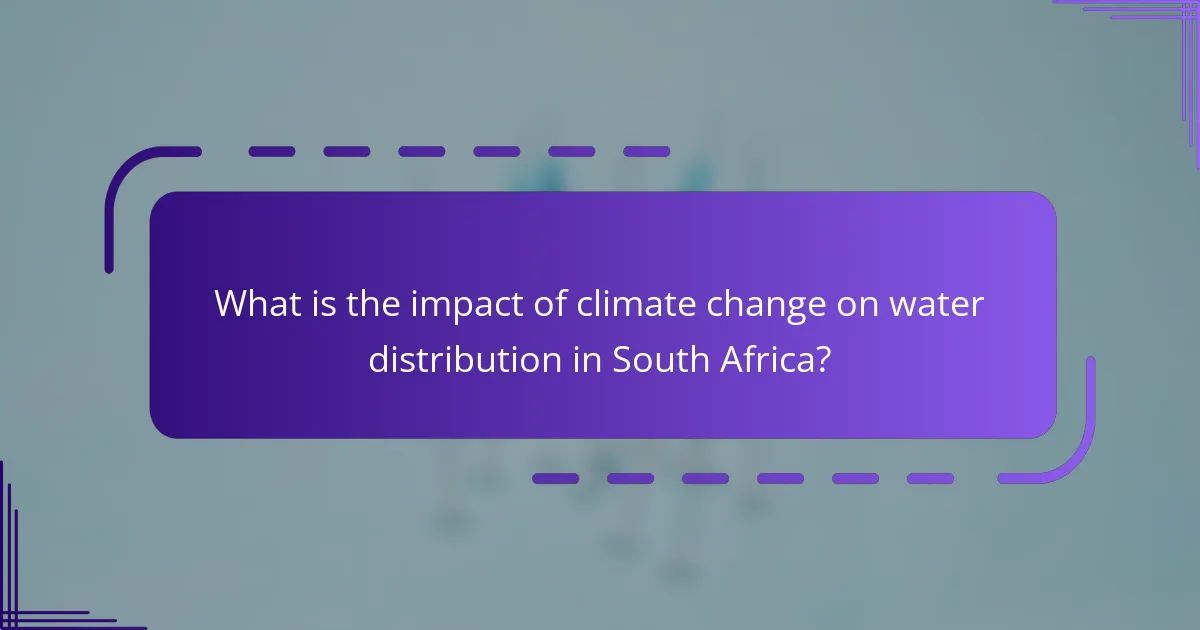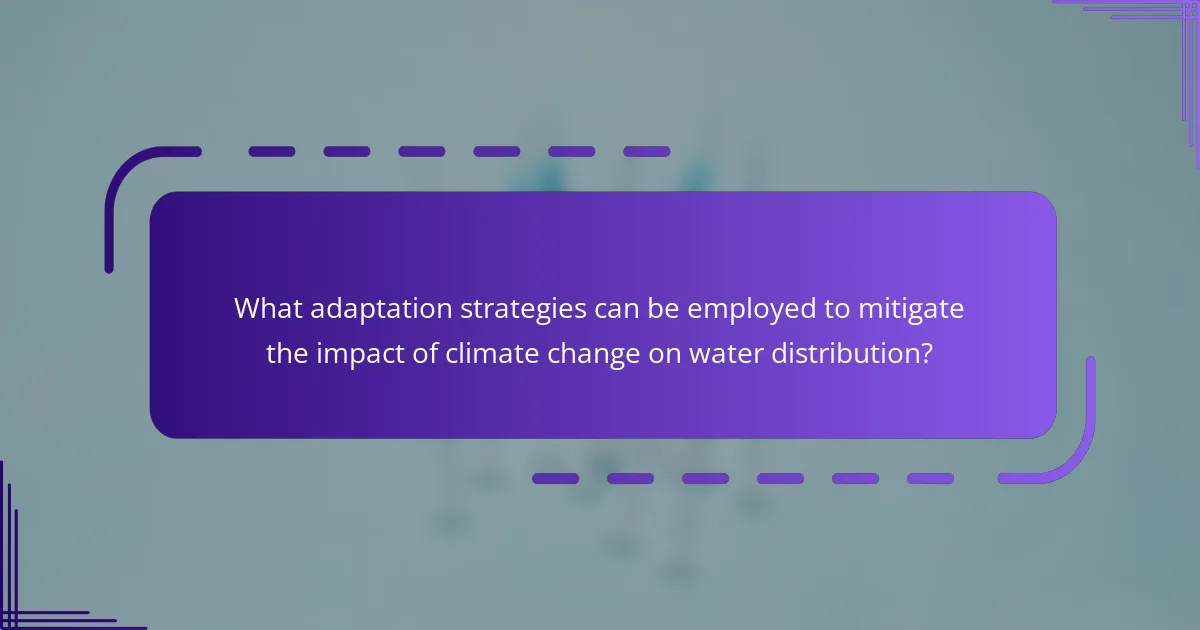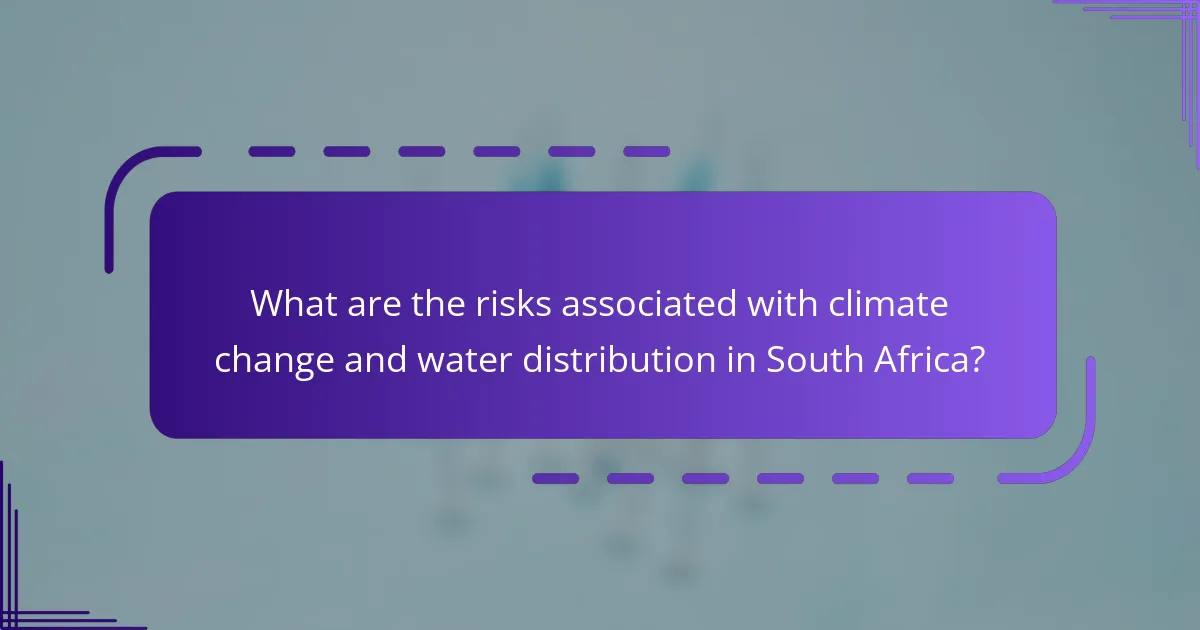Climate change is significantly impacting water distribution in South Africa, leading to altered rainfall patterns and increased temperatures. These changes result in more frequent droughts and intense rainfall in different regions, disrupting freshwater availability and threatening food security and economic stability. Adaptation strategies such as improved water management practices, efficient irrigation systems, rainwater harvesting, desalination technologies, and the restoration of wetlands are essential to mitigate these risks. The article explores the implications of climate change on water resources, the associated risks to vulnerable communities, and the opportunities for enhancing water security through various sustainable practices.

What is the impact of climate change on water distribution in South Africa?
Climate change significantly affects water distribution in South Africa. Increased temperatures lead to altered rainfall patterns. This results in more frequent droughts in certain regions. Simultaneously, some areas experience intense rainfall, leading to flooding. These changes disrupt the availability of freshwater resources. Agriculture, which relies heavily on consistent water supply, faces increased risks. According to the South African National Biodiversity Institute, water scarcity could affect up to 40% of the population by 2030. The overall impact threatens food security and economic stability.
How does climate change affect water availability in South Africa?
Climate change significantly affects water availability in South Africa. Rising temperatures lead to increased evaporation rates. This reduces surface water levels in rivers and dams. Changes in rainfall patterns also contribute to water scarcity. South Africa experiences more frequent and severe droughts. The country’s reliance on rainfall for agriculture exacerbates the issue. According to the South African Weather Service, rainfall has decreased by about 10% over the past decades. This decline threatens both water supply and food security.
What are the observed changes in precipitation patterns?
Observed changes in precipitation patterns include increased variability and intensity. Research indicates that South Africa has experienced shifts in seasonal rainfall. For instance, the average annual rainfall has decreased in some regions. Conversely, certain areas report heavier rainfall events. These changes lead to more frequent droughts and floods. A study by the South African Weather Service highlights these trends. It shows that rainfall patterns are becoming less predictable. This variability affects water resources and agriculture significantly.
How has evaporation increased due to rising temperatures?
Evaporation has increased due to rising temperatures. Higher temperatures enhance the rate of evaporation from water bodies and soil. This process occurs because warmer air can hold more moisture. According to the Intergovernmental Panel on Climate Change (IPCC), global temperatures have risen by approximately 1.1 degrees Celsius since the late 19th century. This temperature rise has led to increased evaporation rates, particularly in regions with high temperatures. For example, studies show that evaporation can rise by about 7% for every 1 degree Celsius increase in temperature. Consequently, as temperatures continue to rise, evaporation rates will likely increase, affecting water availability and distribution.
What are the implications of altered water distribution for South Africa?
Altered water distribution in South Africa leads to significant implications for agriculture, health, and the economy. Changes in rainfall patterns affect crop yields, resulting in food insecurity. For example, the Western Cape has experienced reduced rainfall, impacting wine and fruit production. Water scarcity can also lead to increased competition for resources among communities. This competition may exacerbate social tensions and conflict. Additionally, limited access to clean water can heighten health risks, particularly in vulnerable populations. A report by the South African National Development Plan highlights that climate change could reduce water availability by up to 30% by 2050. Therefore, altered water distribution poses serious risks that require urgent adaptation strategies.
How does water scarcity affect agriculture and food security?
Water scarcity negatively impacts agriculture and food security by reducing crop yields and increasing food prices. Limited water availability leads to drought conditions, which can cause significant reductions in agricultural productivity. For instance, the Food and Agriculture Organization reports that droughts can lead to crop losses of up to 50%. This results in lower food supply and higher market prices. Additionally, water scarcity affects livestock health and productivity, further straining food resources. In South Africa, where climate change exacerbates water distribution issues, food insecurity is becoming more prevalent. The World Bank estimates that water scarcity could increase the number of undernourished people by 25% by 2050 in regions affected by climate change.
What are the socio-economic impacts of changing water distribution?
Changing water distribution has significant socio-economic impacts. It affects agricultural productivity, as farmers rely on consistent water supply. Altered water access can lead to reduced crop yields and increased food insecurity. This, in turn, can raise food prices, impacting low-income households disproportionately.
Additionally, changing water distribution affects livelihoods dependent on fishing and tourism. Communities may face economic decline if water sources become scarce or polluted. Health outcomes can also deteriorate due to inadequate water supply and sanitation.
Research shows that in South Africa, water scarcity can lead to increased conflict over resources. The World Bank reports that water stress can exacerbate poverty levels. Therefore, changes in water distribution have far-reaching socio-economic consequences.

What adaptation strategies can be employed to mitigate the impact of climate change on water distribution?
Adaptation strategies to mitigate the impact of climate change on water distribution include improving water management practices and investing in infrastructure. Efficient irrigation systems can reduce water waste in agriculture, which is crucial in South Africa’s arid regions. Rainwater harvesting systems can capture and store rainwater for later use, enhancing water availability. Desalination technologies can provide alternative water sources in coastal areas. Restoring wetlands can improve natural water filtration and storage. Implementing water pricing can encourage conservation and reduce excessive use. Climate-resilient crop varieties can help sustain agricultural productivity with less water. These strategies are supported by studies indicating their effectiveness in enhancing water security under changing climate conditions.
How can water management practices be improved?
Water management practices can be improved through enhanced efficiency and technology integration. Implementing smart irrigation systems can significantly reduce water waste. These systems utilize sensors to optimize water usage based on soil moisture levels. Additionally, rainwater harvesting can supplement existing water supplies. This practice captures and stores rainwater for later use, reducing dependency on traditional sources.
Moreover, promoting water recycling and reuse in urban areas can alleviate pressure on freshwater resources. According to the World Bank, cities that adopt water recycling can reduce their demand for potable water by up to 30%.
Education and community involvement are also crucial for effective water management. Engaging local populations in water conservation initiatives fosters a culture of sustainability. Implementing policies that incentivize water-saving technologies can further drive improvements.
Lastly, regular assessment of water quality and availability ensures that management practices adapt to changing environmental conditions. This proactive approach is essential in addressing the impacts of climate change on water distribution.
What role do rainwater harvesting and storage play?
Rainwater harvesting and storage play a crucial role in enhancing water security. They collect and store rainwater for future use, reducing dependency on conventional water sources. This method helps mitigate the impacts of climate change, which often disrupts water distribution. In South Africa, where water scarcity is a pressing issue, rainwater harvesting can provide a sustainable alternative. According to the Water Research Commission, it can contribute to domestic water supply and irrigation needs. This practice also helps recharge groundwater levels, ensuring a more resilient water supply system.
How can technology enhance water distribution efficiency?
Technology can enhance water distribution efficiency through smart metering and real-time monitoring systems. Smart meters provide accurate data on water usage and leaks. This data enables utilities to respond quickly to issues, reducing water loss. Real-time monitoring allows for immediate detection of system inefficiencies. Geographic Information Systems (GIS) help in mapping and managing water distribution networks. Automation and control systems optimize water flow and pressure. According to the World Bank, implementing these technologies can reduce water losses by up to 30%. Enhanced data analytics further improve decision-making in water management.
What policies can support sustainable water management?
Integrated water resource management (IWRM) policies can support sustainable water management. IWRM promotes the coordinated development and management of water, land, and related resources. This approach aims to maximize economic and social welfare without compromising the sustainability of vital ecosystems. Policies should include regulations for water quality and conservation practices. They must also incentivize water-saving technologies in agriculture and urban areas. Furthermore, stakeholder engagement in decision-making processes is essential for effective implementation. Evidence shows that countries adopting IWRM have improved water efficiency and reduced conflicts over water resources. South Africa’s National Water Act exemplifies a legal framework supporting IWRM principles.
How can local communities be engaged in water conservation efforts?
Local communities can be engaged in water conservation efforts through education and awareness programs. These initiatives can inform residents about the importance of conserving water. Workshops can teach practical methods for reducing water usage at home. Community events can promote the installation of water-saving devices. Collaboration with local governments can facilitate access to resources and funding. Incentives can encourage residents to adopt water-efficient practices. Evidence shows that communities involved in conservation efforts see a significant reduction in water consumption. For example, a study by the Water Research Commission in South Africa found that community engagement led to a 20% decrease in household water use.
What role do government regulations play in adaptation strategies?
Government regulations are crucial in shaping adaptation strategies for climate change. They provide frameworks that guide resource allocation and management. Regulations set standards for water conservation and usage, promoting sustainable practices. They also enforce compliance with environmental protection measures. Additionally, regulations can incentivize innovation in water-saving technologies. For example, the South African government has implemented policies to improve water efficiency in agriculture. These regulations are essential for minimizing risks associated with climate change impacts on water distribution.

What are the risks associated with climate change and water distribution in South Africa?
Climate change poses significant risks to water distribution in South Africa. These risks include increased drought frequency and severity, which can lead to water shortages. Rising temperatures contribute to evaporation, further reducing water availability. Changes in rainfall patterns can disrupt existing water supply systems. Flooding events, exacerbated by climate change, can damage infrastructure. This can lead to contamination of water sources. Vulnerable communities face heightened food and water insecurity. The agricultural sector, heavily reliant on consistent water supply, is particularly at risk. Overall, climate change threatens the sustainability of water resources in South Africa.
What are the potential environmental risks?
Potential environmental risks include water scarcity, habitat loss, and increased flooding. Climate change can lead to altered precipitation patterns in South Africa. This results in reduced water availability for ecosystems and agriculture. Habitat loss occurs as species struggle to adapt to changing conditions. Increased flooding can damage infrastructure and disrupt communities. These risks threaten biodiversity and food security. According to the IPCC, climate change impacts are expected to intensify, affecting water resources. Effective adaptation strategies are essential to mitigate these risks and protect the environment.
How does habitat degradation relate to water distribution changes?
Habitat degradation significantly impacts water distribution changes. Degraded habitats often lose vegetation cover, which is crucial for maintaining soil moisture. This loss can lead to increased runoff and reduced groundwater recharge. Consequently, water becomes less available for ecosystems and human use. Research indicates that deforestation can decrease local rainfall by up to 30%. Additionally, urbanization contributes to habitat loss, exacerbating water scarcity. In South Africa, these changes threaten agricultural productivity and water security. Therefore, habitat degradation directly correlates with alterations in water distribution patterns.
What are the implications for biodiversity?
Climate change significantly impacts biodiversity in South Africa. Altered water distribution affects ecosystems and species survival. Drier conditions lead to habitat loss for many flora and fauna. Changes in water availability disrupt food chains and breeding cycles. Increased temperatures can cause species migration to cooler areas. This shift may result in competition among species for resources. Loss of biodiversity can weaken ecosystem resilience. Ecosystems with reduced biodiversity are less able to adapt to further environmental changes.
What are the risks to human health and safety?
Climate change poses significant risks to human health and safety, particularly through water distribution issues in South Africa. Altered rainfall patterns can lead to water scarcity, increasing the risk of dehydration and related health problems. Contaminated water sources may arise from flooding, leading to waterborne diseases such as cholera and dysentery. Increased temperatures can exacerbate heat-related illnesses, especially among vulnerable populations. Additionally, food security may decline due to agricultural disruptions, resulting in malnutrition. The World Health Organization highlights that climate change can lead to an increase in vector-borne diseases, further threatening public health. Overall, the interconnectedness of climate change, water distribution, and health underscores the urgent need for adaptive strategies.
How does water quality get affected by climate change?
Climate change negatively impacts water quality through increased temperatures and altered precipitation patterns. Higher temperatures can lead to the proliferation of harmful algal blooms in water bodies. These blooms produce toxins that contaminate drinking water sources. Altered rainfall patterns contribute to runoff that carries pollutants into water systems. Increased flooding events can overwhelm sewage systems, leading to untreated wastewater entering waterways. Drought conditions can concentrate pollutants in diminished water supplies. According to the Intergovernmental Panel on Climate Change (IPCC), these changes pose significant risks to freshwater ecosystems and human health.
What are the risks of waterborne diseases in changing climates?
Changing climates increase the risks of waterborne diseases. Higher temperatures can enhance the growth of pathogens in water sources. Extreme weather events can lead to flooding, contaminating drinking water supplies. Drought conditions may reduce water availability, forcing people to use unsafe sources. Altered rainfall patterns affect the distribution and quality of water. Increased runoff can carry pollutants into water bodies. Vulnerable populations are at greater risk due to inadequate sanitation and health infrastructure. According to the World Health Organization, climate change could lead to an additional 2.5 billion cases of waterborne diseases by 2030.
What opportunities arise from addressing these challenges?
Addressing the challenges of climate change on water distribution in South Africa presents significant opportunities. Improved water management can enhance agricultural productivity. This could lead to increased food security for the population. Investment in water infrastructure can create jobs and stimulate economic growth. Innovative technologies for water conservation can reduce wastage and improve efficiency. Enhanced collaboration among stakeholders can foster community resilience. Policy reforms can promote sustainable practices and attract funding. Overall, proactive adaptation strategies can lead to a more sustainable and equitable water distribution system.
How can investment in water infrastructure lead to economic growth?
Investment in water infrastructure can significantly lead to economic growth. Improved water infrastructure enhances access to clean water. This access boosts public health and reduces healthcare costs. Healthier populations can work more effectively, increasing productivity. Additionally, reliable water supply supports agriculture and industry. Enhanced agricultural output can lead to food security and export opportunities. Economic studies show that every dollar invested in water infrastructure can yield substantial economic returns. For example, the World Bank estimates that water investments can generate an economic return of $4 for every $1 spent. This correlation highlights the crucial role of water infrastructure in driving sustainable economic development.
What innovations can emerge from adapting to water distribution challenges?
Innovations that can emerge from adapting to water distribution challenges include smart water management systems. These systems utilize IoT technology to monitor water usage in real-time. They can significantly reduce water loss through leaks. Another innovation is the development of decentralized water supply systems. These systems provide localized solutions to meet community needs. Rainwater harvesting technologies can also be enhanced for better efficiency. Advanced filtration and purification methods can ensure water quality. Furthermore, data analytics can optimize water distribution networks. These innovations collectively address the challenges posed by climate change on water distribution.
What practical steps can individuals and communities take to adapt to water distribution changes?
Individuals and communities can adapt to changes in water distribution by implementing water conservation techniques. These techniques include installing rainwater harvesting systems to collect and store rainwater. Communities can promote xeriscaping, which uses drought-resistant plants to reduce water usage. Education on water-efficient practices can be provided through workshops and community programs.
Additionally, repairing leaks in plumbing systems can significantly reduce water loss. Local governments can develop policies that encourage the use of greywater for irrigation. Regular monitoring of water usage can help identify areas for improvement. Collaborating with local organizations can enhance community resilience to water scarcity.
According to the South African National Water Act, sustainable water management is essential for adapting to climate change impacts.
The main entity of this article is climate change and its impact on water distribution in South Africa. The article examines how rising temperatures and altered precipitation patterns lead to increased droughts and flooding, significantly affecting water availability and agricultural productivity. It highlights the socio-economic implications of water scarcity, including food security risks and health concerns, while also discussing potential adaptation strategies such as improved water management practices, technology integration, and community engagement. Furthermore, the article explores the opportunities that arise from addressing these challenges, emphasizing the importance of sustainable water infrastructure investments for economic growth.